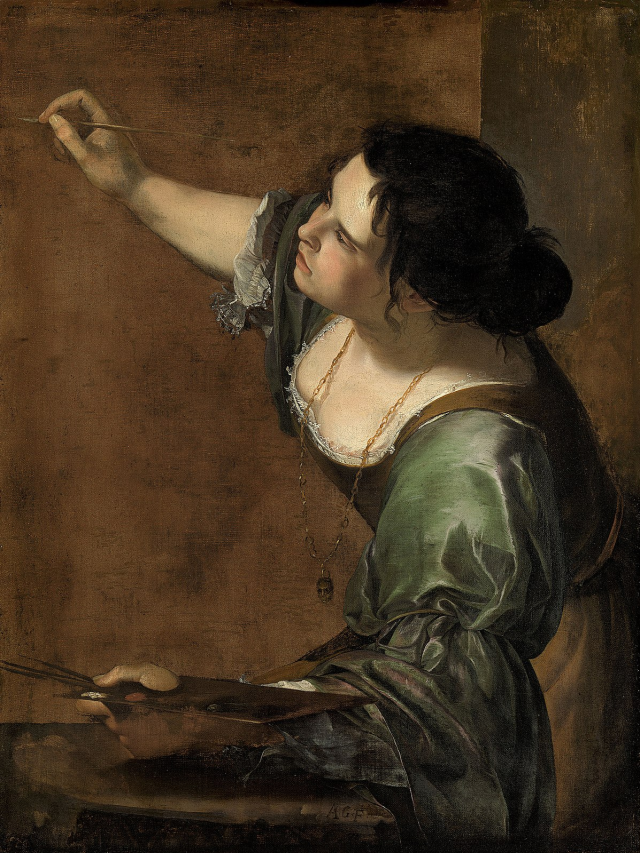Who is Artemisia Gentileschi?
Artemisia Gentileschi, a prominent artist of the Renaissance, was born in Rome in 1593. She defied societal norms and made a lasting impact on the art world with her captivating and evocative paintings. Artemisia Gentileschi’s works centred around the female experience. Through her art, she expressed her personal struggles and brought to life the stories of biblical and mythological heroines. With her unique style characterized by dramatic lighting and expressive figures, Gentileschi’s paintings continue to mesmerize and inspire audiences today.
Art by Artemisia Gentileschi
As we celebrate the birth of Artemisia Gentileschi, let us remember the stories of blood, passion, and captivity that she brought to life on her canvases. Following is a compilation of some of Artemisia Gentileschi’s most notable artworks:
1. Mary Magdalene
Mary Magdalene holds a special place in the artistic repertoire of Artemisia Gentileschi. The renowned Renaissance artist portrayed the biblical figure in several of her notable works, capturing the complexity and emotional depth of this iconic woman. Gentileschi’s depictions of Mary Magdalene often highlight her transformation and spiritual journey, emphasizing her devotion and resilience. Through her masterful brushwork and skillful use of color, Gentileschi breathes life into Mary Magdalene’s story, inviting viewers to connect with her profound experiences of redemption, faith, and unwavering love. Gentileschi’s portrayal of Mary Magdalene stands as a testament to both the artist’s talent and her ability to bring forth the humanity and power of women in her art.

Courtesy Tutt Art
2. Allegory of Painting
Artemisia Gentileschi’s “Allegory of Painting” is a captivating masterpiece that showcases her artistic prowess. The painting, also known as “La Pittura,” depicts a self-portrait of Gentileschi as the personification of Painting. With a brush in her hand and a contemplative gaze, she symbolizes the creative power of art. The piece showcases Gentileschi’s mastery of composition, lighting, and emotional depth, leaving a lasting impression on viewers.

Courtesy: Wikipedia
3. Danae
Artemisia Gentileschi’s “Danae” is a striking and sensual portrayal of the mythological figure. The painting depicts Danae reclining on a bed as golden rain falls upon her, symbolizing Zeus’s seduction. Gentileschi captures the vulnerability and beauty of Danae with remarkable skill, using rich colors and intricate details. The painting exudes a sense of intimacy and captures the emotional intensity of the myth, showcasing Gentileschi’s artistic brilliance.

4. Judith Slaying Holofernes
Artemisia Gentileschi’s “Judith Slaying Holofernes” is a powerful and visceral masterpiece. The painting depicts the biblical heroine Judith in the act of beheading the Assyrian general Holofernes. Gentileschi’s use of dramatic lighting and intense expressions imbue the scene with a sense of urgency and determination. The painting captures the raw strength and courage of Judith, making it an iconic representation of female empowerment and Gentileschi’s artistic genius.

5. Bathsheba
Artemisia Gentileschi’s portrayal of Bathsheba is a poignant and contemplative depiction of the biblical figure. The painting showcases Bathsheba in a moment of solitude and reflection as she gazes into a basin of water. Gentileschi’s skillful rendering captures Bathsheba’s inner thoughts and emotions, evoking a sense of introspection and vulnerability. The painting’s nuanced details and Gentileschi’s masterful use of light and shadow create a profound and captivating portrayal of Bathsheba’s story.

Courtesy: Wikipedia
6. Lucretia
Lucretia By Artemisia Gentileschi is a poignant and emotionally charged depiction of the ancient Roman heroine. The painting captures Lucretia’s tragic moment of despair and resolve, as she holds a dagger in her hand. Gentileschi’s masterful use of light and shadow intensifies the scene, emphasizing Lucretia’s turmoil and inner strength. Through her artistry, Gentileschi breathes life into Lucretia’s story, inviting viewers to connect with her profound courage and sacrifice.

7. Cleopatra
Artemisia Gentileschi’s portrayal of Cleopatra is a captivating and regal depiction of the legendary queen. The painting captures Cleopatra’s allure and power as she reclines on a sumptuous bed, surrounded by opulent fabrics and jewels. Gentileschi’s meticulous attention to detail and vibrant color palette bring Cleopatra to life, emphasizing her beauty and magnetic presence. The painting serves as a testament to Gentileschi’s artistic skill and ability to capture the essence of a powerful historical figure.

8. Aurora
Artemisia Gentileschi’s “Aurora” is a mesmerizing painting that captures the goddess of dawn in all her radiant glory. The artwork showcases Aurora gracefully ascending into the sky, surrounded by swirling clouds and vibrant colours. Gentileschi’s skilful brushwork and attention to detail create a sense of movement and ethereal beauty. The painting transports viewers to a realm of myth and magic, showcasing Gentileschi’s ability to bring divine figures to life on canvas.

9. Susanna and the Elders
The earliest known signature work by Artemisia Gentileschi is “Susanna and the Elders” (1610), which illustrates a biblical story from the Book of Daniel. Two elderly people spy on Susanna while she takes a bath in the painting, and they later ask for sexual favours. When Susanna declines, she is falsely accused of infidelity. Unlike past, more sensualized portrayals, Gentileschi’s interpretation highlights Susanna’s suffering. Regarding Gentileschi’s training, academics make assumptions, citing her father’s influence while highlighting her distinct psychological perspective.







